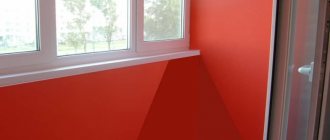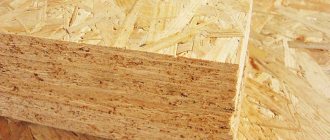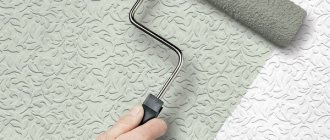1838 0 0
Felix March 27, 2018Specialization: philological education. 20 years of experience as a builder. Of these, for the last 15 years he led a team as a foreman. I know everything about construction - from design and zero cycle to interior design. Hobbies: Vocals, psychology, quail breeding.
Acrylic-based paint composition is excellent for wooden bases.
Greetings, my dear readers.
Acrylic paint for wood is a coating that is often used to protect walls, floors, ceilings, furniture and various objects from external influences. It also gives them aesthetics.
Oil paints often used for external work do not last long. Based on this, the acrylic analogue is more preferable in terms of quality/cost ratio.
Not all of you know how to select paint for wood, because it is necessary to take into account the features and characteristics of the material. Let's figure this out.
What is acrylic paint on wood?
Acrylic compositions are water-based paints, which makes it possible to use them for exterior and interior painting work.
Acrylic compositions are water-based paints, which makes it possible to use them for exterior and interior painting work.
The components that make up paintwork materials provide important characteristics, ensure ease of use, and high-quality wood protection.
Priming wooden walls
The process of preparing a façade for painting includes the priming stage. In order to avoid making mistakes in this matter, you need to remember one rule: external wooden walls cannot be coated with a water-based primer. Only on oil.
As a rule, all high-quality primers are also antiseptics. Before you start, you need to carefully read the instructions on the package. The conditions under which priming with this product can be performed and the manufacturer's recommendations for application will become known.
Primer Tikkurila Valtti Akvabase (Valtti Aquabase)
Valtti Akvabase and BIOFA are considered one of the best primers for wood. These oil-based compounds can be used on any wood: freshly planed, pressure treated, heat-treated, old. When working with Valtti Akvabase, personal protective equipment must be used.
Special antiseptic primer for wood
How to Apply Primer to a Wooden Surface
For a small amount of work, you can use a paint brush with natural or artificial bristles to apply the primer. This tool is especially convenient when processing log facades. If the walls are smooth (plank or timber), you can apply the primer with a roller. This is not difficult to do.
Step 1. Pour enough primer into a paint tray or any other suitable container so that 1/3 of the volume of the roller roller can be immersed in it.
Mix the primer
Pour soil into the tray
Step 2. Dip the roller into the solution and roll it 2-3 times along the relief horizontal part of the paint bath. This removes excess primer, and it will not flow off the wall when applied.
A roller with a foam coat is an excellent tool for applying primer.
Step 3. Moisten a section of the wall by rolling a roller over it. Each subsequent strip should overlap the previous one by 5-7 cm.
Apply primer evenly
Step 4. Dip the roller into the primer again and squeeze it out. Next, work continues according to the given algorithm until the entire area of the facade has been processed.
Applying primer with a brush
Wood with fresh soil
Sand the primed surface after drying
It should be remembered that as little time as possible should pass between the processes of priming and painting. Not all primers are light and UV resistant. Therefore, they need to be covered with a layer of paint in a timely manner.
Types of acrylic paint for wooden surfaces
Acrylic paints vary depending on the area of use. Manufacturers produce the following types of products for wooden structures:
- Acrylic facade paint for wood is used for painting the external walls of buildings and other structures located on the street.
- Universal compositions are used for external painting in various conditions. This wood paint is used for interior work.
- A special type of acrylic paints is for floors. When painted, the floor covering acquires an attractive appearance and increases wear resistance. This type of paint and varnish composition does not tolerate ultraviolet radiation and is susceptible to fading.
- Universal wood paint for exterior use is used in everyday life and industrial environments, ensuring the proper performance of its functions.
The scope of application is specified by the manufacturer on the label, which greatly simplifies the choice of wood treatment product.
The label also indicates how to work with acrylic paints and drying time. The market offers water-based paints and varnishes for wood, glossy and matte. There are also products that imitate a satin or velvet finish. The color range is varied, since white color is easy to change with coloring pigments.
Acrylic paint for wood: environmentally friendly and decorative surface protection
When performing renovation work in a private house, apartment or country house using natural materials, the best option for processing them is acrylic paint . This water-based composition is easy and quick to apply, reliably protects the surface from the effects of adverse factors, while simultaneously giving it a decorative appearance. You can learn about the distinctive features of paint and the rules for choosing it from this article.
Acrylic paint for wood is easy to apply and dries quickly.
Characteristics and composition of acrylic paint
The quality characteristics of acrylic-based paints are determined by the components included in the composition:
- Since the material belongs to the group of water-based paints and varnishes, water is used as a diluent.
- Pigments that determine the color palette. You can purchase a ready-made colored composition or use white, adding a dye yourself to get the desired shade.
- Acrylates that provide the connection of water with pigments and other components.
- Resins that enhance UV resistance.
- Plasticizers that guarantee ease of application. Thanks to them, the layer of acrylic composition is elastic and does not crack after drying.
- Hardeners, thanks to which the paint layer dries quickly.
- Additional components that give the composition the desired qualities.
This component composition determines the main characteristics of acrylic paints for wood:
- ease of use;
- high adhesive qualities;
- duration of operation of the painted surface;
- high drying speed;
- safety for humans, environmental friendliness;
- rich color palette, matte and glossy options, thanks to the addition of a matting component.
Depending on the ratio of the components, individual properties appear to a greater or lesser extent.
Application
The listed properties allow you to paint the outside walls of wooden buildings, as well as individual elements: stairs, gazebos, platbands, decorative details.
Indoors, an acrylic-based product is used for painting ceilings, walls, floors, windows, and doorways. Acrylic compositions are suitable for painting furniture and for artistic painting, and the service life of paint coatings is very long: 5-10 years.
Companies on the market
When choosing acrylic compositions for the home, you should decide on the functions of the coating, since the market offers a wide variety of products from domestic and foreign manufacturers:
- The most common are Finnish-made paints and varnishes Tikkurila and Teknos.
- Germany supplies Alpina and Duka acrylic paints.
- Austria produces compositions based on Adler acrylic.
- The products of the American brand Ace Paint are well known.
- Reliable manufacturers of acrylic paints and varnishes from Russia: “Extra”, “Drevoplast”, “Senezh”, “Aquatex”, “Yaroslavl paints”.
Manufacturers indicate detailed characteristics on the packaging. Product properties affect its cost.
Technology of painting wooden surfaces
Having determined whether it is possible to paint wood outside and inside with acrylic paint, having selected the right type of paintwork material, and calculating the consumption, you should proceed directly to painting. It is important to strictly follow the technology and adhere to the manufacturer’s instructions so that the result is satisfactory.
Preparing wood for staining
Before painting wood with acrylic paint, you should prepare the surface for work. Preparatory activities include:
- Removing old nails or treating them with anti-corrosion agents.
- Removing the old paint layer using a sanding disc or brush.
- Repairing dents and other defects with putty.
- Sanding, leveling a wooden surface.
Before painting wood with acrylic paint, it is necessary to treat the surface with a degreaser, remove resins, and apply an antiseptic and fire-fighting agent. The described procedures are performed with a brush.
Tool
The choice of tool affects the quality, speed of painting, as well as consumption. Depending on the area and characteristics of the wooden surface, use:
- Rollers and brushes are convenient for processing small surfaces. They are easy to paint hard-to-reach places. It is important to select a tool made from synthetic bristles, since they do not absorb water well and are resistant to deformation. Brushes and rollers vary in width, so you can choose the most convenient device. Before painting, the brush should be soaked in warm water.
- Electric or pneumatic spray guns are used to paint large wooden surfaces. They use paint economically and provide high painting speed.
The first option is cheaper, but painting takes a lot of time. In the second case, expensive equipment is required. You can choose simpler versions of spray guns for home use.
Manually
Manual painting requires, in addition to a brush and roller, a special container - a bath. It is equipped with a small ribbed platform that allows you to remove excess paint. This option is convenient when painting smooth wooden surfaces: ceilings, floors. When using hand tools, it is important to ensure even application. If necessary, the composition is applied in several layers. The number of layers applied determines how long it takes acrylic paint to dry on wood. On average, paintwork materials dry in 2-4 hours. Only after the previous layer has completely dried should the next one be applied.
Mechanically
Before starting to work with the spray gun, cover the areas that will not be painted with film. In most cases, additional thinning of acrylic wood paint is required to achieve a flow time of approximately 27 seconds from the gun. The tool is prepared for painting: the mode is set (the speed of painting depends on it), and a test painting is carried out in a separate area. For uniform application, set the spray mode to medium and work from a distance of half a meter. At the end of the work, it is necessary to check the result and eliminate shortcomings: smudges, omissions.
Padding
Applying a primer is mandatory before painting wood surfaces. Priming allows you to improve adhesive properties, reduce material consumption, provide additional surface protection, and extend the service life of the paintwork. It is selected depending on the location of the work:
- oil - for the street;
- water-based - indoors.
The composition is applied with a brush or roller. The number of layers is determined depending on the condition of the surface.
Since primers are not resistant to ultraviolet radiation, you should begin painting immediately after the primer composition has dried, the duration of which does not exceed 3 hours.
Applying paint
When painting, it is better to immediately brush along the edges and joints, and then begin the main painting. The technology of work depends on the tool used. In some cases, 1 coat of paint is sufficient, but sometimes recoating may be required. When painting wooden structures that are subject to large mechanical loads, a third layer will be required.
Consumption
Thanks to their good hiding characteristics, acrylic-based paints and varnishes are used sparingly. The approximate consumption is indicated by the manufacturer on the packaging. It can be taken into account when calculating the required amount of acrylic paint on wood. You should also take into account the condition of the surface and carry out thorough preparation, since a smooth, cleaned, pre-primed wooden surface will require less paint.
Acrylic compositions for wood are considered the most reliable and high-quality, as they have a number of advantages over other types. Properly selected paints and varnishes will provide reliable protection and an attractive appearance of wood for many years.
Preparing the facade for painting
Preparing walls for painting is an extremely important step that cannot be ignored. First of all, carefully inspect the surface of the facade. If the house has been previously painted, take a putty knife with a metal blade and check how firmly the old finishing layer holds.
Fresh paint cannot be applied to such a surface.
If the paint comes off easily, you need to remove it. Depending on the thickness of the coating, choose a tool for the job. If the layer is thin and can be easily separated from the walls, a spatula and a brush with metal bristles will be sufficient.
Sharpen your putty knife to make old paint easier to remove.
Removing paint with a spatula
A thick layer, which in some places adheres firmly to the walls, will require the use of an angle grinder (grinder) with a special attachment: a cord brush for rough processing of wood. It (the brush) can remove not only the old finishing layer, but also level the wooden surface. Sandpaper discs will not help with this job.
Cord brush for angle grinders, bowl-shaped
If the old paint comes off easily, you can use 80-120 GRIT sanding discs. It is recommended to take into account that when removing the finishing layer, a significant amount of dust will be generated containing small fragments of the old coating. Therefore, it is necessary to protect the respiratory system with a respirator or cloth bandage.
Sanding flap disc
Sanding is a very hard and unpleasant job, as the sandpaper constantly becomes clogged with paint.
Preparing the surface for painting
Before you begin cleaning the facade mechanically, you must remove all nails, if any. If it is not possible to remove them, hammer them in with a hammer. If the nail heads are rusty, unsightly stains will appear on the new finish coat over time. Therefore, the metal is treated with red mercury or special anti-corrosion removers. The latter are preferable, since they, unlike mercury, are not poisonous.
For treating rusty nails, drainpipes, etc. use red mercury
If the walls are built from logs, mechanical processing is excluded. In this case, other techniques are used to prepare the facade for painting. First of all, you need to check the density of the space between the logs. It is usually filled with tow, moss or hemp. These materials must be compacted in those places where it is required. After that, dirt and dust are removed from the surface of the logs with a rag or broom.
Filling seams with sealant











